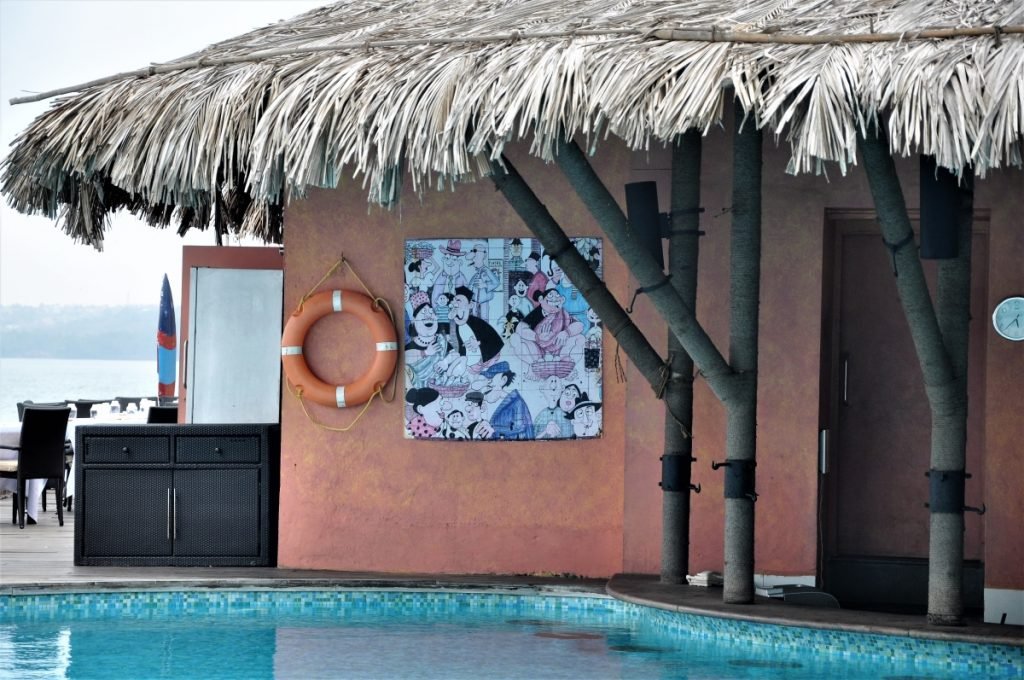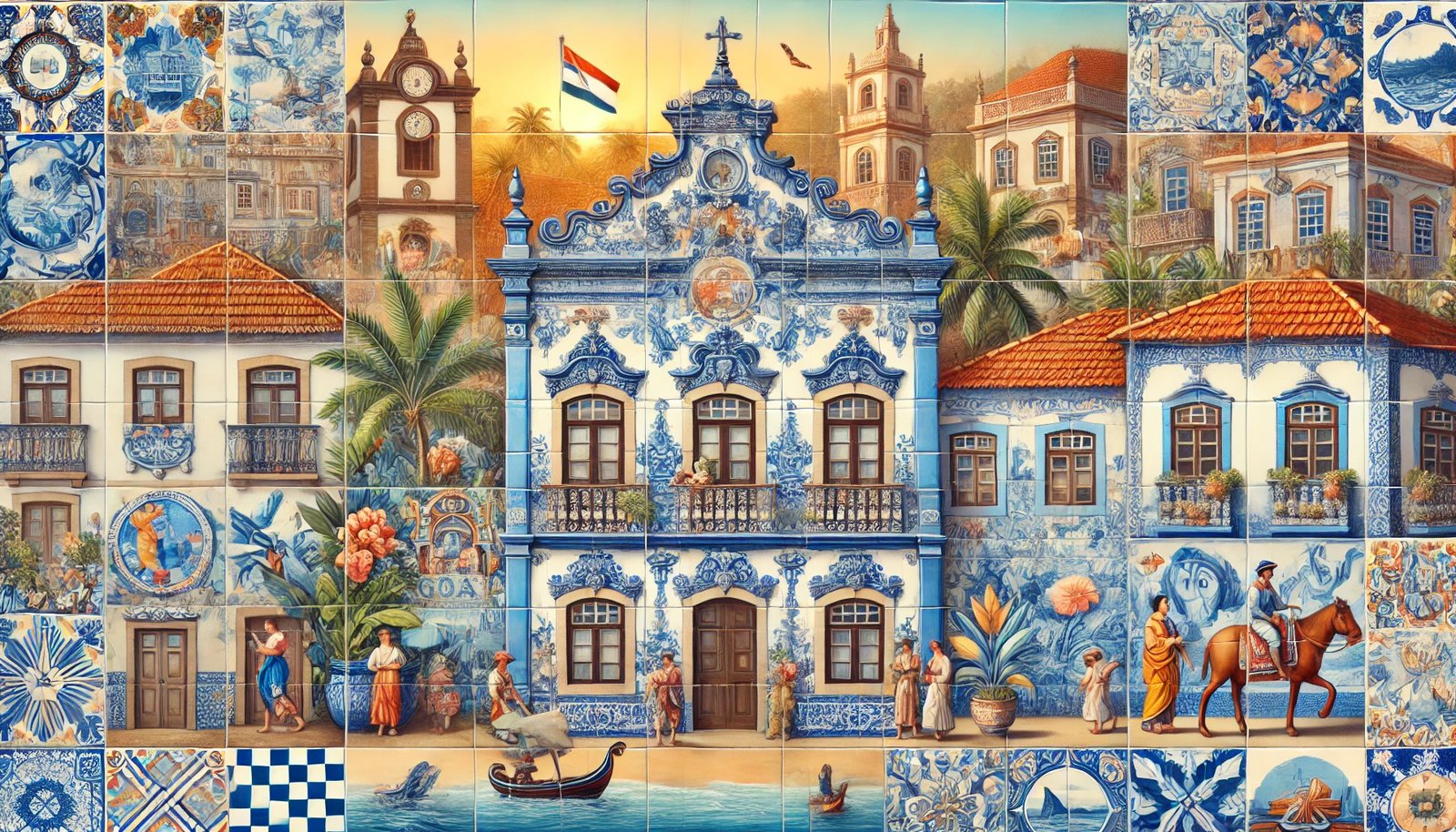As one walks through the Goan architectural landscape, one can’t help but notice the colourful tilework across the buildings. These vibrant glazed tiles can be found as frames, borders and even as big mosaics. Though they have been part of the Goan buildings since Portuguese rule, it is only recently that they have resurfaced as important cultural symbols.

The Goan Azulejos
The white and blue tile work which has become synonymous with the Goan heritage is a product of Portuguese colonialism of the region and the local Goan cultural identity. The white and blue tiles or Azulejos, as they are called, reached Goa after travelling miles across the Iberian Peninsula. Each tile is a piece of art. They are meticulously hand painted, usually telling stories about the land and its inhabitants, then glazed at high temperatures of 1,000 to 1,100 ℃. Though the tiles are Portuguese in origin, Goans have adopted the technique to tell the indigenous stories. One can find these tiles across the Goan landscape, as name plates, on the hotel walls, as murals, on the public buildings etc., making it a symbol of the local Goan heritage.

Localisation of a foreign art
The purpose and visual iconography of the Azulejos of Goa has evolved with their patrons. They first came to Goa with the Portuguese colonists and hence the earliest artworks tell the stories of the Portuguese conquest. The Institute Menezes Braganza in Goa is adorned with these massive mosaics. They depict the scenes from the voyage of Vasco da Gama’s to Calicut from an epic called Os Lusíadas, authored by Luís Vaz de Camões. Each tile has been hand painted by the celebrated artist Jorge Colaço. Interestingly all the tiles were painted in Portugal and then shipped to Goa.

However recent artworks are not restricted to the epic stories but are also based on local Goan caricatures, scenes of the Goan landscape and the local lives. There is a shift from the larger than life tales to the comforting mundane stories. Local artists have adopted the technique and the vibrant Azulejos are produced locally now. They have become important and colourful icons of Goans reclaiming their distinct identity by assimilating their colonial past with their local culture. These tiles are great examples of how art travels and becomes an important element of the built heritage of a region. This is a striking instance of assimilation and adaptation of a foreign technique to form a unique vernacular identity.

Contemporary Art
Though the art was lost for a long time after the Portuguese left, Goans are reclaiming the Azulejos now. The art was brought back to the region by Orlando de Norhona, who gave the Azulejos a contemporary touch in his Panjim studio and popularised the art again in the 2000s. The beautiful tilework adorns many public buildings, hotels, sideways and are an important part of many heritage buildings. Contemporary artists have adopted the technique for smaller canvas. Nowadays they are immensely popular as nameplates, souvenirs, plates, tables etc. Hence anyone can now own a piece of this beautiful art. Azulejos are important examples of a built heritage technique being adopted for smaller objects, thereby both preserving and disseminating the technique far and wide. The tiles have become immensely famous amongst tourists which usually depict the Goan heritage, rural and urban life and also many caricatures. The Azulejos also portray that traditional techniques can be easily modernised and popularised amongst the masses if the modern context and needs are taken into consideration.

The Azulejos of Goa have been a symbol of Portuguese rule. The art was lost and forgotten. However modern interventions and renewed interests in the aesthetics of these tiles has revived the art. Also the adoption of local subjects and landscapes as new themes has helped the Goans in establishing their local and distinct heritage using the Azulejos. These tiles are not only important for their ornamental use but they are important tools of disseminating Goa’s history and heritage across time and space. The art is a witness of Goa’s transformation from Portuguese rule to the present. Each Azulejo continues to tell the colourful tales of the Goans and their beautiful lands.

References
- de Carvalho, Rosário Salema. “The iconographic role of azulejo frames.” Word & Image 36, no. 2 (2020): 135-165.
- Fernandes, Jason Keith. “INDO-PORTUGUESE ART AND THE SPACE OF THE ISLAMICATE.” (2008): 41-50.
- https://www.thisday.app/story/the-arrival-and-revival-of-azulejo-in-goa-25346
- https://ijhssm.org/issue_dcp/A%20Critical%20Review%20on%20the%20Historical%20background%20of%20Goan%20Murals.pdf
- https://www.outlooktraveller.com/explore/culture/the-art-of-goas-azulejo-tiles
- http://velhagoa.net/blog/2019/02/26/azulejos-hidden-gem-of-goa/
- https://www.joinpaperplanes.com/the-azulejos-in-panajis-former-central-library/
- https://azulejosdegoa.com/personalised-name-plaques/
- https://chloethinksalot.wordpress.com/2020/02/07/storytelling-in-goa/
